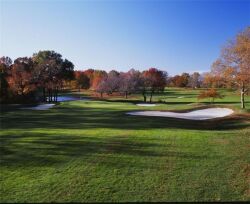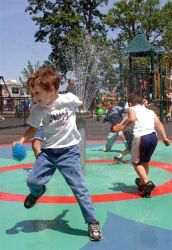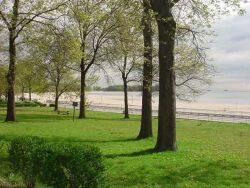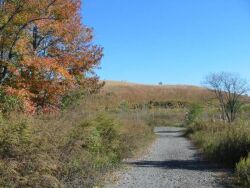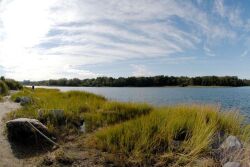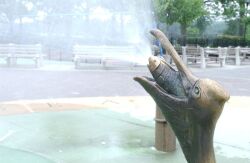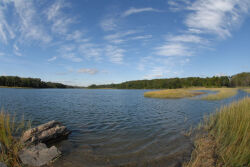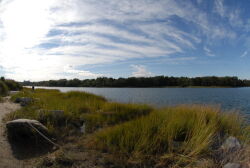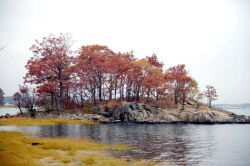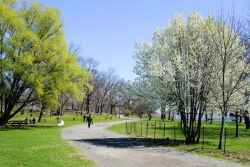Pelham Bay Park
The Daily Plant : Tuesday, August 30, 2005
WHAT’S OLD IS NEW AGAIN
Located just north of Orchard Beach in the Bronx, Hunter Island contains 166 acres of contiguous forest—the largest natural area in Pelham Bay Park. But perhaps even more impressive is the diversity of plant life that thrives there. Hundreds of species grow, including dozens of plants native to lower New York State. Now more than ever, we seek to preserve this plant life as we maintain one of the City’s unique natural environments.
Hunter Island was once a remote, forested region on the western edge of the Long Island Sound. The area remained relatively undisturbed until 1803, when a wealthy auctioneer named John Hunter built an imposing mansion atop the island’s highest point. Hunter introduced an English-style garden with trees, shrubs, and flowering plants that had not previously existed in the local environment. In 1937, Parks Commissioner Robert Moses connected the island to the Bronx mainland using dredged sand from the Rockaways during the construction of Orchard Beach.
Though Hunter’s mansion was demolished during this proces, the plants he brought in during its construction have colonized much of the area and threaten the island’s original plant life. Despite the threat, tracts of the original "old growth" forest remain. Oaks and tulip trees persevere, traces of the primeval forest that once dominated this area. A huge Northern Red Oak, "Big Red," stands with a trunk 48 inches in diameter at breast height (dbh). The largest tulip tree measures more than 55 inches dbh.
Brief inspection informs us of this forest’s heritage. When trees age, they begin to acquire a balding bark at the base of their trunks. The mere presence of this textured bark indicates an age of at least 150 years in most trees. Several of Hunter Island’s trees not only display this bark, but also wear it along several feet of their trunk. Many naturalists believe that this patch of old growth may have existed during the American Revolution, despite local written accounts, which state that no forest survived the fight for independence. Hunter Island’s trees and undergrowth may even resemble those found in forests of 8,000 years ago. The area’s significance as a record of our environment’s past cannot be underestimated.
Just as special as Hunter Island’s arboreal treasures, though, is the diversity of herbaceous plants that occupy the forest’s ground layer. Native shrubs and vines populate the understory. Many of the plants, including wildflowers, are rare. Lousewort, Alumroot, and Broad Beech Fern, all present on Hunter Island, are virtually absent in other New York City parks. Even the Carrion Flower, listed on New York State’s directory of endangered plant and wildlife species, flourishes. The only other places in New York State where the flower can be spotted are Van Cortlandt Park and Staten Island.
Altogether, our team has accounted for at least 49 native herbaceous species. But the encroachment of at least four invasive, non-native species introduced during the island’s settlement now threatens the demise of this forest. Extensive areas have already been lost. Day-lily patches march on, eliminating everything in their path. Oriental Bittersweet vines have made serious inroads in many areas. As Oriental Bittersweet advances toward the canopy, it entwines the circumference of trees, forming dense thickets that shade out growth on the forest floor. Porcelain-berry, another type of vine not known in the park even during the mid-1980s, has also moved into the area.
We began counteracting this threatening growth in 2003. Adam Thornbrough of Parks & Recreation’s Natural Resources Group and his crew began the restoration effort by cutting Siebold’s Viburnum. Hundreds of seedlings were removed by hand, along with Day-lily and the thickest areas of Bittersweet and Porcelain-berry. However, considerable work remains in order to bring these two vines under control. Species with currently small populations, such as Japanese Maple and Multiflora Rose, should be eliminated as soon as possible, as they can reproduce in the blink of an eye.
Once the growth of invasives is brought under control, the project will continue on a smaller scale to maintain the site and ensure the future of Hunter Island’s old-growth forest. This method of management by subtraction allows nature to self-restore once non-native species are removed. Hunter Island can serve as a model for full forest recovery at similar sites across the Bronx and the rest of New York City. We face a crucial moment: acting now will allow us to counteract non-native growth, while preserving the original forest, a natural treasure.
-written by David S. Künstler
QUOTATION FOR THE DAY
"Keep your love of nature, for that is the true way to understand art more and more."
Vincent Van Gogh
(1853-1890)
Check out your park's Vital Signs
Clean & Safe
Green & Resilient
Empowered & Engaged Users
Share your feedback or learn more about how this park is part of a
Vital Park System

Know Before You Go

Contacts
Pelham Bay Park Administrator's Office: (718) 430-1891
Bartow-Pell Mansion Museum: (718) 885-1461
Park Enforcement Patrol: (718) 430-1815

